Meditations on time, history, and myth
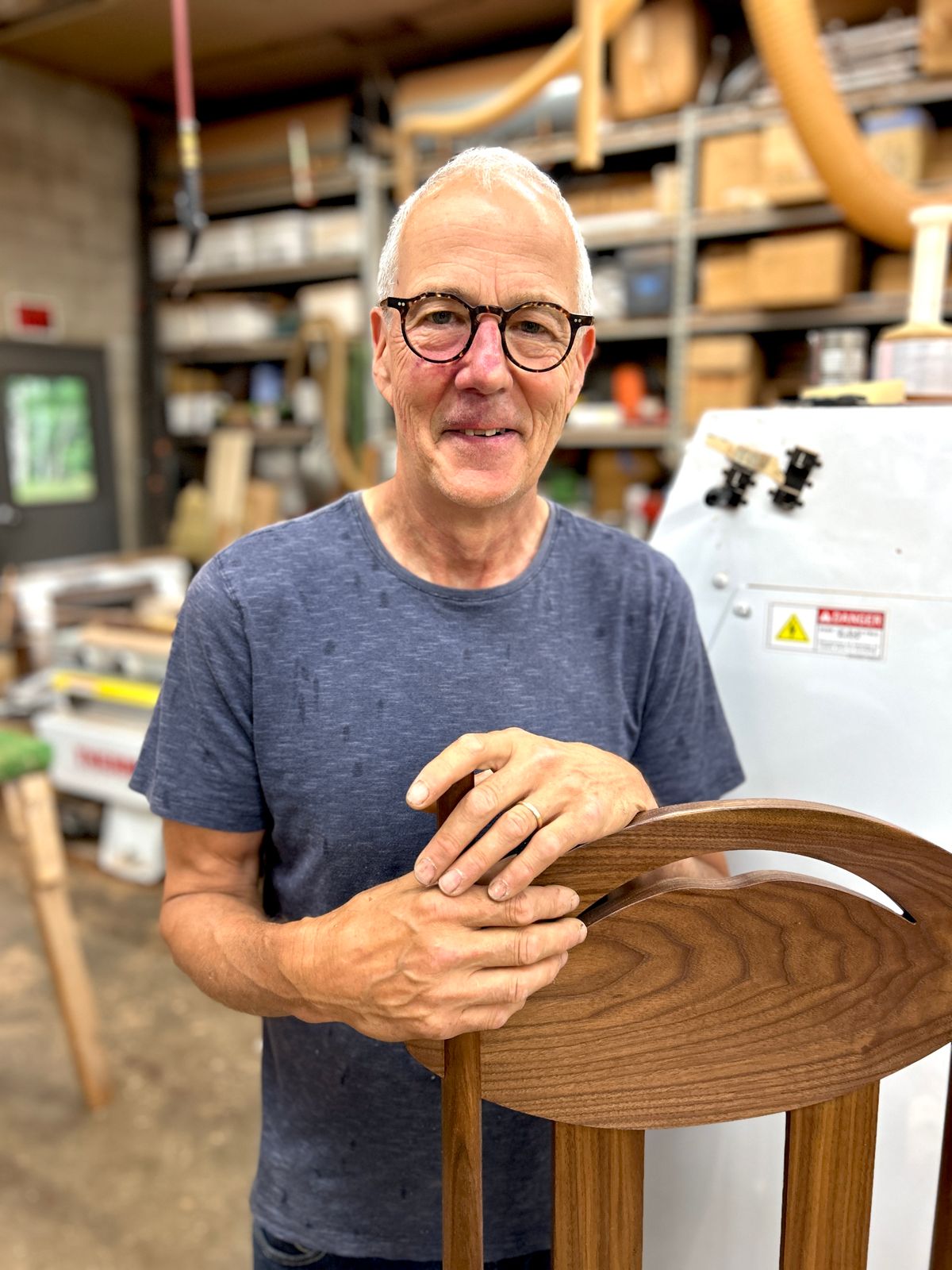
Norfolk woodworker Mark Burke in his shop with his walnut chair based on a design by Scottish architect/designer Charles Rennie Mackintosh (1868-1928).
Jennifer Almquist

Norfolk woodworker Mark Burke in his shop with his walnut chair based on a design by Scottish architect/designer Charles Rennie Mackintosh (1868-1928).
Three friends have joined forces to exhibit their art in a pop-up gallery exhibit in the Royal Arcanum building at Station Place in Norfolk. From Aug. 16 through Sept. 2, painter Ann Getsinger and woodworkers Mark Burke and Peter Murkett will show their furniture, painting, sculpture and objects. Kozmik Braid is the name they coined for their eclectic offering. According to the artists the name is “a riff on each other’s work, weaving utilitarian furniture with pure art.”
Norfolk woodworker Mark Burke said of their friendship, “I have collaborated with Peter on projects for probably 25 years and have always been impressed by his sense of design. He can make subtle changes that instantly make the piece more pleasing. Peter introduced me to Ann, who is well-known in the Northwest Corner and is very passionate and energized with her creativity. I am thrilled to participate in this Art and Design Pop-Up exhibition with them both.”
Burke continued, “My initiation into woodworking was out of necessity, followed by three and a half decades of accumulating tools and essential knowledge. Over time you witness many designs by others and are slowly inspired to find your own spin on things. Slowly tweaking and playing with everything that passed by, having total creative freedom within my shop.”
Burke professionally uses computers to draw plans and program electronically controlled tooling to cut wood parts. His playful spirit is given free rein in the work he has made for this show, which includes chair designs based on Scottish architect and designer Charles Rennie Mackintosh (1868-1928) and furnishings and objects informed by the work of architect Frank Lloyd Wright.
Burke’s pieces include lyrical music stands made of black walnut, a graphic metal light echoing Wright’s complex geometric patterns, and a minimal dining table that embodies architect Louis H. Sullivan’s 1896 design principle: Form follows function.
Burke said, “People working with wood can often choose to use figured material. I have chosen to use more subdued lumber so that it is the joinery of the shapes and the overall piece that attracts your eye.” Burke’s precision marries perfect joinery with his deep knowledge of wood. Rather than break free of technology, he has bent it to his creative vision.
Jennifer Almquist
Southfield woodworker Peter Murkett demonstrating the translucence of the thin wood wall sconce he designed.
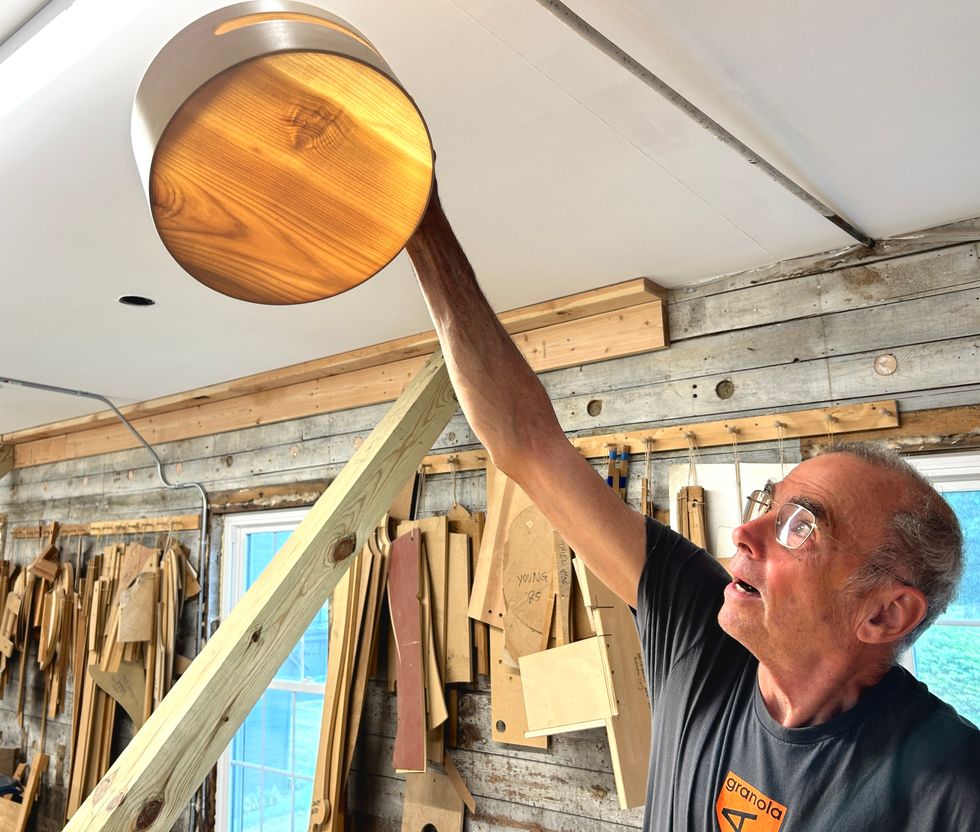
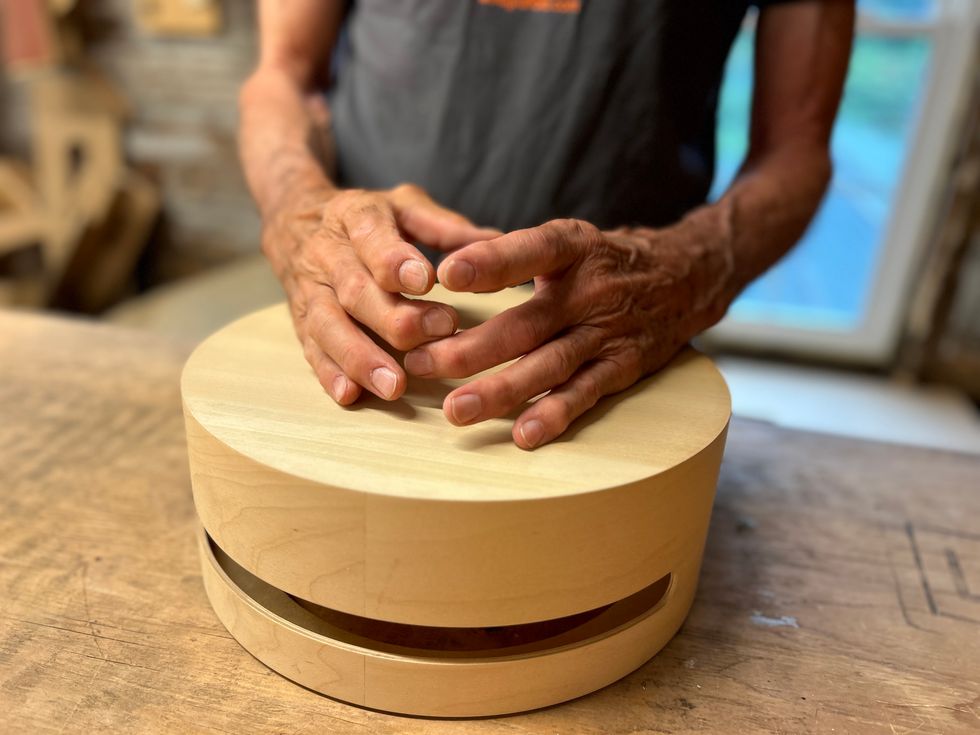
Southfield, Massachusetts-based Murkett’s love of the simplicity of Shaker design is evident in the clean lines and functionality of his creations. Murkett cradles a perfectly formed bowl in his weathered hands and explains how the Shakers added the curved handle for hanging the water dipper on the edge of their buckets.
“I was struck by the turned form of the Shaker dipper at first sight. This handled bowl that must have been turned on a lathe in the shape of a bowler hat, with the brim mostly cut away to make the handle. The Shakers thrived in the early years of industrial development, mid-nineteenth century. They valued machines like the lathe for the efficiency they offered in reproducing shapes. But handling a Shaker dipper was a revelation: the shape begged to be cradled in the hand; they have an uncanny, tactile appeal that seems to replicate the visual appeal of Shaker design,” mused Murkett. Other examples of his work, informed also by the grace of Windsor chairs, can be found at www.newenglandmodern.com. According to Murkett, his objects and sculptures are “meditations on time, history, and myth.”
With his mystical sense of history, meaning, and a poet’s quiver, Murkett conjures up stories and subtle ironic nods to current events within his wooden objects. His skill is that of a master craftsman. One expects secret drawers and hidden messages within his dovetails.
After a lifetime making furniture to grace the homes and gardens of countless clients, Murkett will be showing his own designs. A talismanic carving, created when he was a boy of twelve, forms the soul of his offerings in this upcoming exhibit. This odd little object remains an icon to Murkett, and inspired his poem:
The Boy I Was
1.
The boy I was had a cheap set of woodcarving tools
maybe six—a gouge or two, a veining tool, others too.
The professional I later became never tossed them out
or used them again. Memento only, and good for that,
like the object that boy carved which still remains
(although the making lies buried deep, beyond reach):
a head in lightbulb shape, wide-open eyes (gouge)
a tidy mop of hair (veiner), a mustache (ditto),
no chin, all in mahogany, cleanly bored to fit snug
on the shifter tip of the family ’56 Plymouth,
the car he learned to drive.
2.
Decades later I resurrected the shifter tip
that boy carved so long ago, hardly knowing how,
the wood long separated from the car
(new in his boyhood) now a junk somewhere
or even less than that—but maybe more:
meltdown steel remade as what? a machine, a tool,
a part fit to some greater whole, used anew.
My father, bent by many years walking
now grips the shifter tip atop his cane,
the head from off the column upright at last
in the hand of my old man. I adjust my step to his,
glad we go this way together.
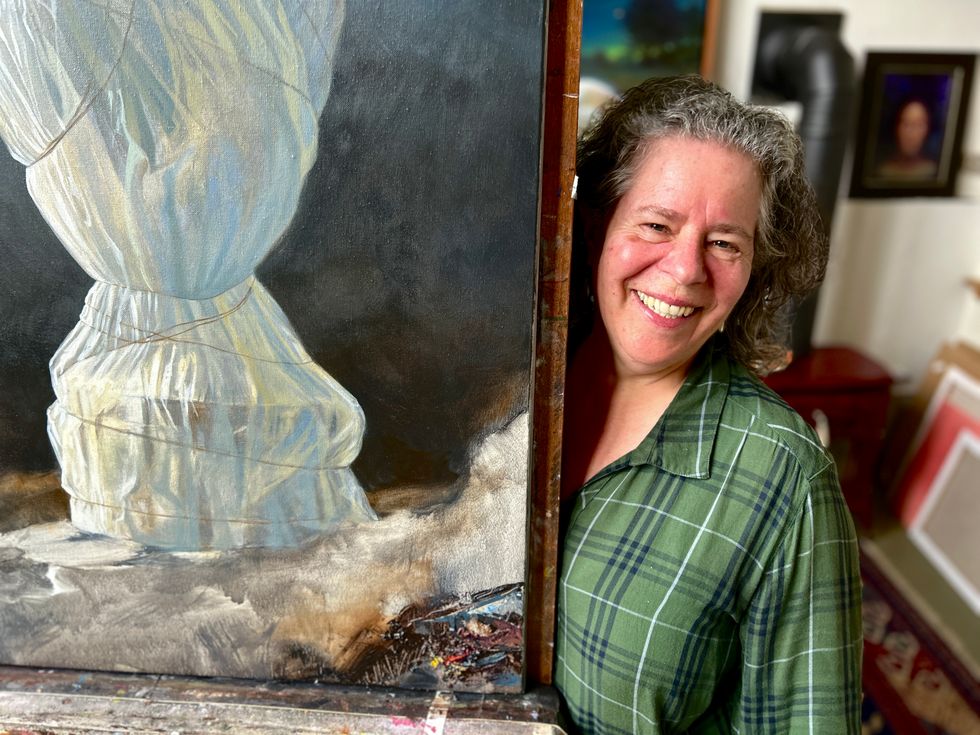
Ann Getsinger (anngetsinger.com) paints fantastical landscapes which include deep evening sunsets, skulls of wild animals, seashells, and natural flora and fauna. Dreamlike and evocative, her skilled oil paintings contrast human cycles with the cycles found in nature.
Getsinger said of her art, “My work is more connected to the recent offshoots of the realist tradition, for example, Jamie Wyeth as he expands on the spectrum of carefully observed work into pure abstraction all expressed within the same image. Life is both observable and unseeable, feelings come and go, stories unfold multidimensionally, and it’s all pure change. How can a human being bear this… without art?”
In the center of her studio, built in 1988 in a meadow in New Marlborough, Massachusetts, a tall window lets in the cold Northern light. A velvet drape, the color of clematis, gives her workspace the mood of a Renaissance atelier. On her tall French easel an oil painting of an enigmatic rooster in a shroud adds a surreal element. Getsinger, who is represented by galleries in Maine and nearby Housatonic, Massachusetts, will be showing new, unexpected work in this Norfolk show including an “umbilical” figurative drawing (over six feet wide) and a flying sculpture. Her weaving of the metaphorical through her work, and the aesthetic she shares with Burke and Murkett, inspired the title of their show, Kozmik Braid.
Gallery hours: 11 a.m. – 5 p.m., Friday, Saturday, Sunday, and by appointment (413) 717-2530
Opening reception on Friday, Aug. 16, from 4 – 7 p.m.
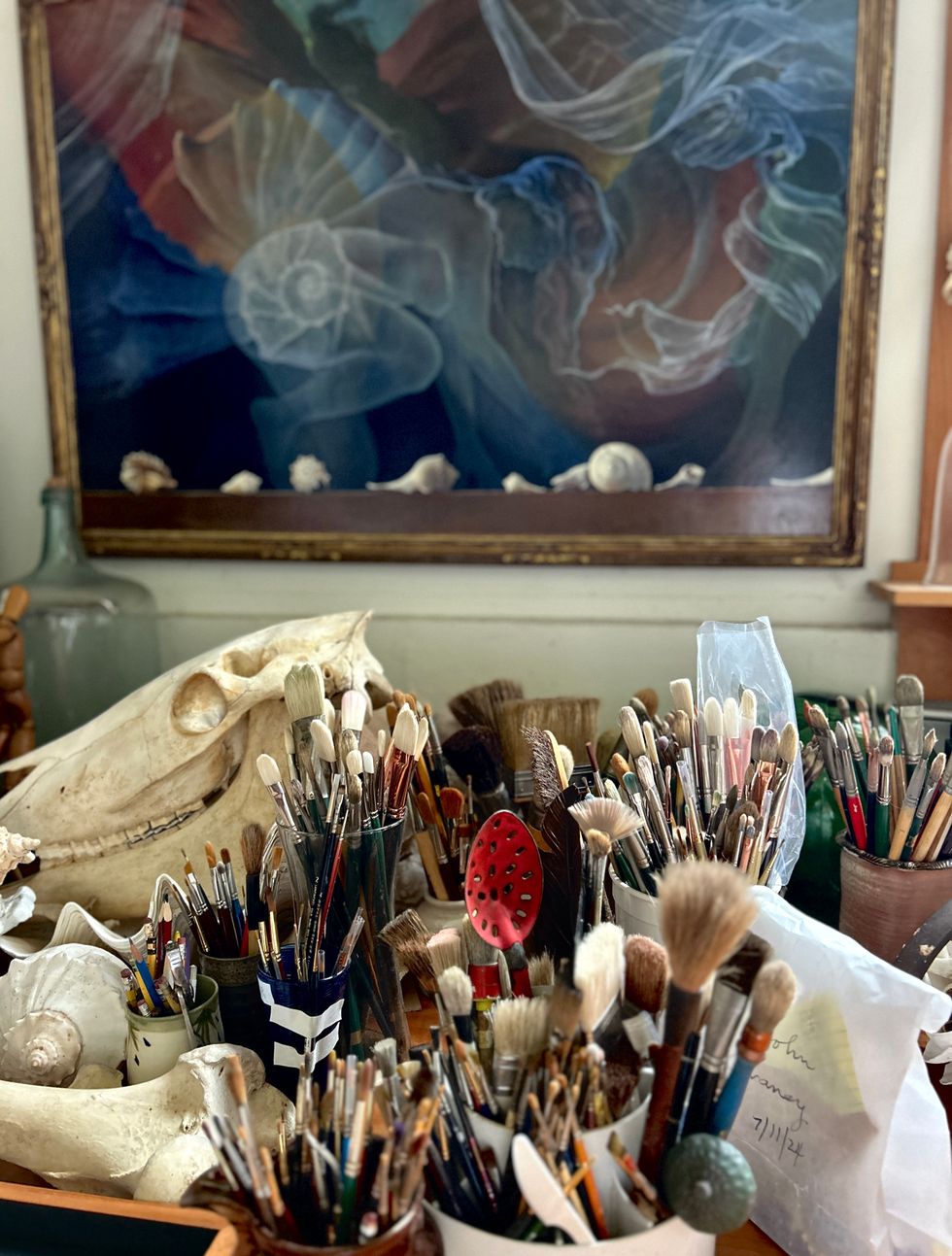
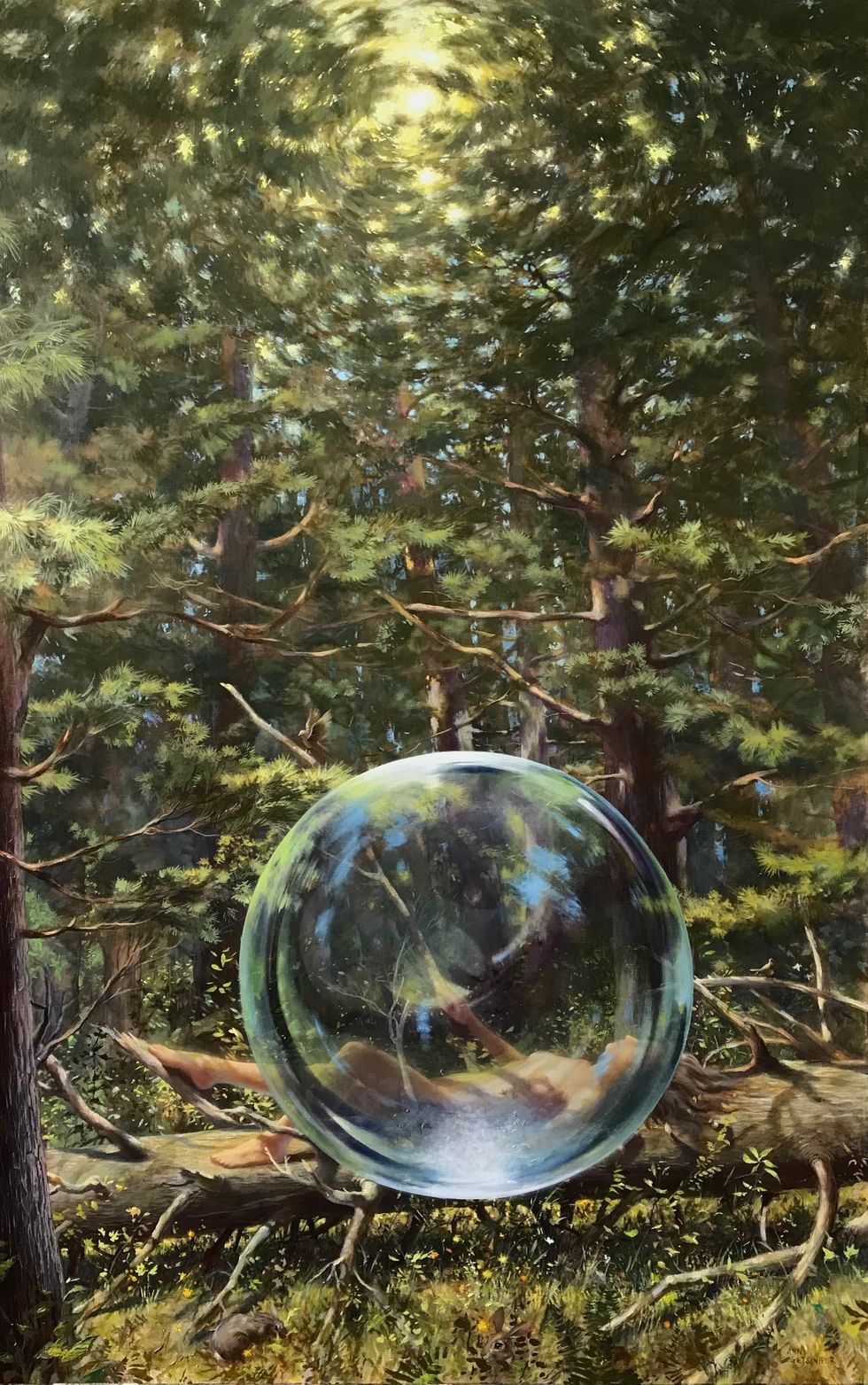
HVRHS’s Victoria Brooks navigates traffic on her way to the hoop. She scored a game-high 17 points against Nonnewaug Tuesday, Dec. 16.
FALLS VILLAGE — Berkshire League basketball returned to Housatonic Valley Regional High School Tuesday, Dec. 16.
Nonnewaug High School’s girls varsity team beat Housatonic 52-42 in the first game of the regular season.
The atmosphere was intense in Ed Tyburski Gym with frequent fouls, traps and steals on the court. Fans of both sides heightened the energy for the return of varsity basketball.
HVRHS started with a lead in the first quarter. The score balanced out by halftime and then Nonnewaug caught fire with 20 points in the third quarter. Despite a strong effort by HVRHS in the last quarter, the Chiefs held on to win.
Housatonic’s Victoria Brooks scored a game-high 17 points and Olivia Brooks scored 14. Carmela Egan scored 8 points with 14 rebounds, 5 steals and 4 assists. Maddy Johnson had 10 rebounds, 4 steals, 2 assists and 2 points, and Aubrey Funk scored 1 point.
Nonnewaug was led by Gemma Hedrei with 13 points. Chloe Whipple and Jayda Gladding each scored 11 points. Sarah Nichols scored 9, Bryce Gilbert scored 5, Gia Savarese scored 2 and Jazlyn Delprincipe scored 1.
CORNWALL — At the Dec. 9 meeting of the Planning and Zoning Commission, the commission had a pre-application discussion with Karl Saliter, owner of Karl on Wheels, who plans to operate his moving business at 26 Kent Road South, which is an existing retail space.
Saliter said he will use the existing retail section of the building as a mixed retail space and office, and the rear of the building for temporary storage during moving operations.
There will be no external “personal” storage proposed for the property.
The commission decided that Saliter should go ahead with a site plan application under the regulations for “retail stores and trades.”
P&Z also set a public hearing on a proposed text amendment on dimensional requirements for properties in the West Cornwall General Business (GB) zone. It will be held Jan. 13, 2026, at 7 p.m. at the Cornwall Library.
FALLS VILLAGE — The Board of Selectmen at its Dec. 17 meeting heard concerns about the condition of Sand Road.
First Selectman David Barger reported a resident came before the board to talk about the road that is often used as feeder between Salisbury and Canaan.
“The person said there is not proper maintenance of that road and it is often the scene of accidents,” Barger said in a phone interview. “There is a problem with the canopy of trees that hang over it, making it hard to keep clear, but there is also the problem of speeding, which is terrible.”
As a former state trooper, he said he is familiar with the problem of drivers going too fast on that road, describing one case in which he had to charge someone for traveling way above the speed limit.
Barger said the town cannot reconfigure the roadway at this time, but officials and road crew members will keep an extra eye on it as a short-term solution.
In other business, Barger said the selectmen plan to call a town meeting sometime next month. Residents will be asked to take the remaining funds, which total $48,200, from the non-recurring capital fund to allow for Allied Engineering to perform engineering studies on the proposed salt shed. Money for construction has already been secured through a STEAP grant, which the town received in the amount of $625,000.
“We’re looking at critical infrastructure projects and this is one component,” he said.
At that town meeting, there will also be a vote to take $2,000 from the town’s discretionary fund to pay Cardinal Engineering for work on repair of the Cobble Road bridge.